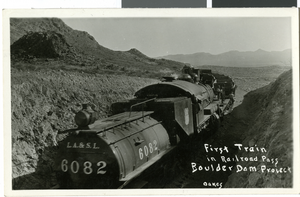Search the Special Collections and Archives Portal
Search Results

View of Tonopah from Railroad Depot: photograph
Date
Archival Collection
Description
Image

Transcript of interview with Howard E. Hollingsworth by Joseph Concannen, February 23, 1979
Date
Archival Collection
Description
On February 23, 1979, collector Joseph Concannen interviewed educator, Howard E. Hollingsworth (born October 3rd, 1927 in Preston, Idaho) in J. D. Smith Junior High School in Las Vegas, Nevada. This interview covers the history of Nevada. Mr. Hollingsworth also discusses the Mormon Fort, ranches, and the railroad.
Text

Postcard of a Union Pacific Railroad train, during Hoover Dam construction, late 1920s - early 1930s
Date
Archival Collection
Description
Image

Transcript of interview with Ralph Daly by Charles Malkowski, February 25, 1977
Date
Archival Collection
Description
Text

Transcript of interview with Earl A. Evans by Lance Malone, March 15, 1981
Date
Archival Collection
Description
On March 15, 1981 Lance Malone interviewed Sears Roebuck Division Manager, Earl A. Evans, Jr., (born March 3rd, 1935 in Alhambra, California) in Las Vegas, Nevada. This interview covers the history of Nevada and Mr. Evans’s life. During the interview, Mr. Evans discusses education, sports, employment, the weather and the railroad in Las Vegas. He also discusses transportation, recreation, community involvement, raising a family in Las Vegas, the development of Fremont and the Strip, and religious activities. Mr. Evans served as a Bishop for the LDS Church in Las Vegas and in regards to education, he served on the Clark County School Board.
Text

Group of unidentified people at a Union Pacific Railroad at unknown location: photographic print
Date
Archival Collection
Description
Dorothy Bell Scans UNLV-Public Lands Institute
Image

Unidentified man standing on railroad tracks: photographic print
Date
Archival Collection
Description
Bell Family Scrapbook scanning, Set 4, proofed 11.04.2010 Unidentified man standing on railroad tracks in the Mojave Desert. Several unidentified buildings are in the distance
Image

Letter from W. R. Armstrong (Los Angeles) to E. E. Cunningham, August 17, 1928
Date
Archival Collection
Description
Logandale, Nevada lacked a water system and McNamee thought that if the railroad supplied Bishop Jones with water, others would expect the same.
Text

Transcript of interview with John Brooks by Jeff Kennedy, February 28, 1979
Date
Archival Collection
Description
Text
Jacqueline Abell oral history interview
Identifier
Abstract
Oral history interview with Jackie Abell conducted by Robert Stuart on April 03, 1976 for the Ralph Roske Oral History Project on Early Las Vegas. Jackie Abell (b. 1924) discusses her experiences growing up in Virginia City, Reno, and Overton, Nevada. She specifically discusses her experiences growing up on a ranch, railroading, above ground atomic testing, flooding, and wild animals.
Archival Collection
